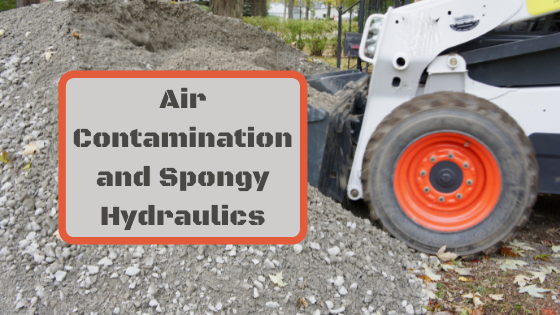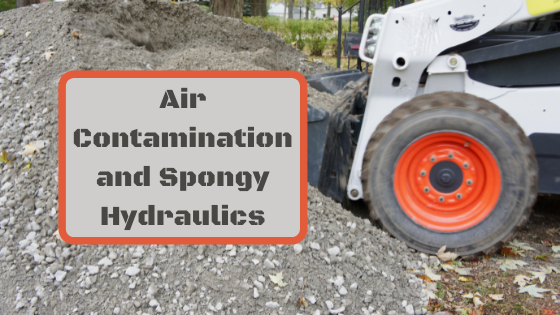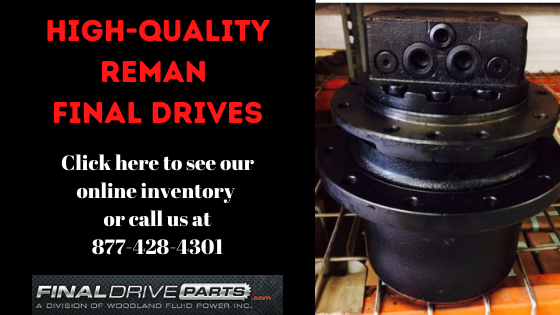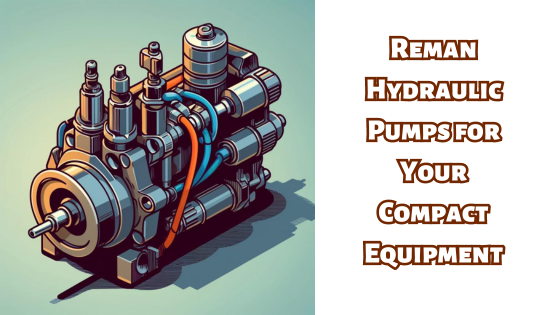Air Contamination and Spongy Hydraulics
Posted by Dr. Sara McCaslin on Feb 5th 2022
What does it mean when your final drive (or other hydraulic components) are slow to respond or seem "spongy"?

Here are a few other Shop Talk Blog posts that you might find helpful:
- Final Drives: Reactive Maintenance or Preventive Maintenance?
- Water Contaminated Hydraulic Fluid
- 6 Types of Hydraulic Drive Motor Contamination
Bulk Modulus
For a hydraulic fluid to be effective, it must be extremely stiff. This stiffness, or resistance to compression, is what allows the hydraulic fluid to transmit high pressures and forces to components like the final drive motors and hydraulic cylinders in your equipment. But exactly how stiff is hydraulic fluid?
One way to measure that resistance to compression (or stiffness) is the bulk modulus of elasticity. To understand what the bulk modulus of elasticity is, we can look at a simplified equation for it:
Bulk Modulus = Change in Pressure / (Change in Volume / Volume)
Basically, it looks at how a change in pressure affects the volume of a substance. The substance can be a liquid, gas, or even a solid. In the case of hydraulic fluid, we want a change in pressure to have minimal effect on the volume, which means it needs to have a high bulk modulus.
Air Versus Hydraulic Fluid
Hydraulic fluid will compress approximately 0.5% for every 1000 psi exerted, giving it a bulk modulus of 20,000 psi.
Bulk Modulus = 1,000 psi / 0.05 = 20,000 psi
The bulk modulus of air, on the other hand, is approximately 14,650 psi.
Entrained Air
Some air contamination in your hydraulic system is ok and to be expected. However, problems arise when you have entrained air: air bubbles dispersed throughout the hydraulic fluid. Entrained air means that you have bubbles that are less than 1 mm in diameter (about the thickness of your driver’s license card or credit card) that are suspended below the surface of your fluid. When you have foaming, those bubbles rise to the top of the fluid and are easy to spot. Entrained air, however, isn’t as easy to see.
Entrained Air Contamination Symptoms
One of the side effects of entrained air contamination is, as described by Machinery Lubrication Magazine, is “spongy hydraulics.” This means that your final drive motor doesn’t perform as well under a load, and its controls seem sluggish.
This happens because the bulk modulus of air is less than the hydraulic fluid. When it becomes dispersed throughout the fluid, the overall bulk modulus within your system is reduced. As more air enters the hydraulic fluid, the resulting mixture isn’t as stiff. Therefore, when loads and pressure are applied, not as much force can be transmitted to your drive motors, hydraulic cylinders, and attachments.
And the spongy effect means that it will start taking more time to complete tasks and can eventually impact the productivity of the operator and the machine. And, according to Hydraulics Online, you might also notice much louder operation and overheating of your hydraulic system (including your final drive motor).
Preventing Entrained Air and Spongy Hydraulics
Regular maintenance can help you avoid these common sources of entrained air:
- Clogged inlet filters
- Low hydraulic fluid levels
- Clogged reservoir breathers
You can also …
- Bleed the system correctly
- Avoid splashing when you’re adding hydraulic fluid to the system
- Pre-fill components before installing them
Conclusion
Preventing entrained air contamination will help prevent spongy hydraulics and sluggish responses. And it will help you get better performance out of your hydraulic final drive motors!









